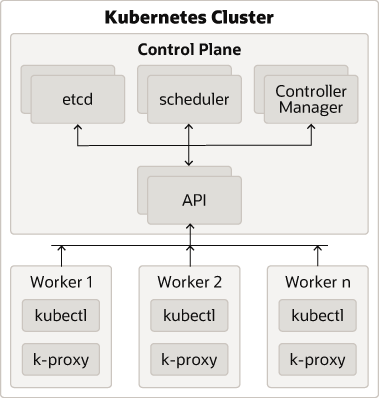3.2 About the Kubernetes Architecture
A Kubernetes host consists of a control plane and worker nodes.
Control Plane: A control plane is responsible for managing the Kubernetes components and deploying applications. In an enterprise deployment, you need to ensure that the Kubernetes control plane is highly available so that the failure of a control plane host does not fail the Kubernetes cluster.
Worker Nodes: Worker nodes which are where the containers are deployed.
Note:
An individual host can be both a control plane host and a worker host.Figure 3-1 An Illustration of the Kubernetes Cluster

Description of Components:
-
Control Plane: The control plane comprises the following:
- kube-api server: The API server is a component of the control plane that exposes the Kubernetes APIs.
- etcd: It is used to store the Kubernetes backing store and all the cluster data.
- Scheduler: The scheduler is responsible for the placement of containers on the worker nodes. It takes into account resource requirements, hardware and software policy constraints, affinity specifications, and data affinity.
- Control Manager: It is responsible for running the controller processes.
Controller processes consist of:
- Node Controller
- Route Controller
- Service Controller
The control plane consists of three nodes where the Kubernetes API server is deployed, front ended by an LBR.
-
Worker Node Components: The worker nodes include the following components:
- Kubelet: An Agent that runs on each worker node in the cluster. It ensures that the containers are running in a pod.
- Kube Proxy: Kube proxy is a network proxy that runs on each node of the cluster. It maintains network rules, which enable inter pod communications as well as communications outside of the cluster.
- Add-ons: Add-ons extend the cluster further, providing such services as:
- DNS
- Web UI Dashboard
- Container Resource Monitoring
- Logging